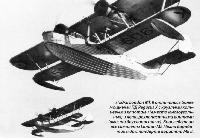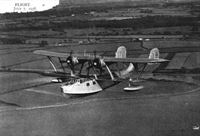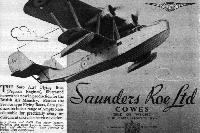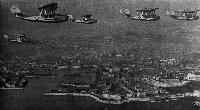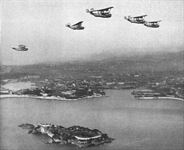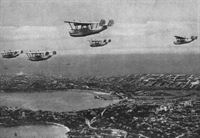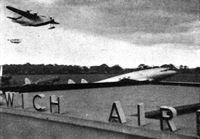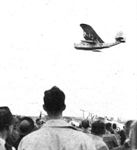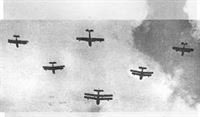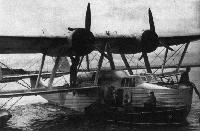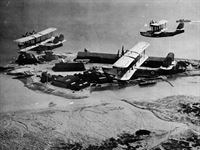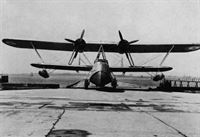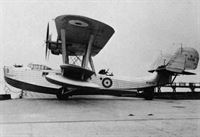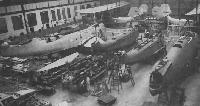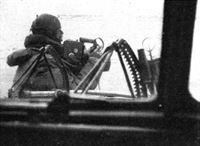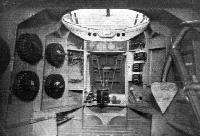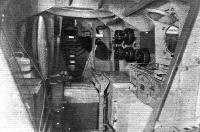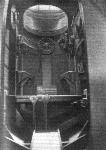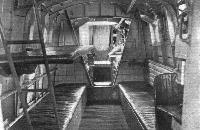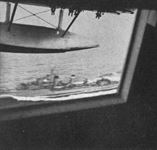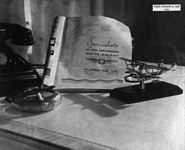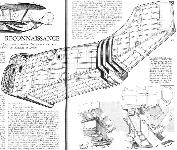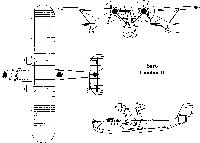
Описание
Страна : Великобритания
Год : 1934
Летающая лодка
Патрульная летающая лодка
London / A.27
Летающая лодка, двухмоторный цельнометаллический биплан с двухкилевым оперением. Двигатели установлены на верхнем крыле. Самолет был создан в КБ фирмы "Саундерс Роу" под руководством Г. Ноулера как развитие типа А.7 ("Северн"). Особенностью конструкции являлась возможность перевозки громоздких грузов на верхней части фюзеляжа. Опытный образец лодки А.27 вышел на испытания в апреле 1934 г. Серийное производство гидросамолетов "Лондон" освоили на заводе "Саундерс Роу" в Ист-Коувсе в апреле 1936 г. Крылья в собранном виде поставлялись фирмой "Боултон-Пол". Всего выпустили 48 экз.
Экипаж - 5-6 чел. Двигатели - в зависимости от модификации. Вооружение 3x7,69, бомбы до 1500 кг (нормальная нагрузка - 900 кг).
"Лондон" состоял на вооружении британских ВВС с октября 1936 г.
Выпускались две модификации:
- "Лондон" I с моторами "Пегасус" III в многогранных капотах, впоследствии все самолеты этого типа доработали под стандарт типа II;
- "Лондон" II с моторами "Пегасус" X в круглых капотах, строились с ноября 1936 г.
С декабря 1937 г. проводилась модернизация самолетов с установкой дополнительного наружного бензобака на фюзеляже.
С конца 1936 г. лодки "Лондон" поступили в эскадрильи Берегового командования в метрополии, с 1938 г. их разместили также на Мальте. С сентября 1939 г. они начали патрулирование Северного и Средиземного морей. В Гибралтаре машины этого типа базировались до конца 1941 г. Использовались как разведчики и самолеты ПЛО.
Производство "лондонов" прекратили в мае 1938 г. Из строевых частей в Англии эти летающие лодки изъяли в апреле 1941 г., на вооружении учебных подразделений они состояли до июня 1942 г.
"Лондон" II||
Размах:||24,4 м
Длина:||17,3 м
Моторы, количество х мощность:||2х 960 л. с.
Взлетная масса, максимальная:||10880 кг
Максимальная скорость:||250 км/ч
Практический потолок:||6070 м
Дальность:||2800 км
Описание:
- London / A.27
- Saro A.27 London
- Flight, February 1934
A NEW SARO FLYING BOAT - Flight, March 1936
FOR OPEN-SEA RECONNAISSANCE
Фотографии
-
Мировая Авиация 230
Этот камуфлированный Saro London служил в 240-й эскадрилье Берегового командования британских ВВС. В 1940 году это подразделение действовало в составе 15-й авиагруппы из Странраера на юго-западе Шотландии. Для увеличения продолжительности полета на фюзеляже установлен дополнительный топливный бак.
-
Jane's All the World Aircraft 1938 / 03 - All the world's aeroplanes
Регистрационный номер: K3560 [6] The Saro "London" Open-sea Reconnaissance and Coastal Patrol Flying-boat (two Bristol "Pegasus" engines).
-
Flight 1935-05 / Flight Advertisements
Регистрационный номер: K3560 [6] The SARO LONDON, fitted with two “Bristol” Pegasus engines, is a twin-engined flying boat designed for open-sea reconnaissance and coastal defence. Constructed by Saunders Roe, Ltd., the London has accommodation for a crew of six - two pilots, a navigator, an engineer, a rigger and a wireless operator, and it carries a very full equipment, including wireless. Standard equipment of the Royal Air Force. A flight of five of these machines, in formation, is on its way to Australia, on a goodwill visit.
-
Flight 1935-08 / Flight
There will be at least three squadrons of Saro "Londons." These are very sturdy boats with two 690 h.p. "Pegasus III's."
-
Flight 1935-06 / Flight Advertisements
SARO LONDON. Used for many years by the R.A.F. and on active service during the early part of the war, the Saro London Mk. 2 was a twin-engined open-sea reconnaissance flying-boat biplane. The motors were Bristol Pegasus X supercharged radials of 1,000 h.p. each. First Londons were produced in 1934. There was a gun- and bomb-aimers' position in the nose and further gunners' positions amidships, and in the tail of the hull. Span was 80 ft.; length 56 ft. 6 in.; all-up weight 18,400 lb.; and top speed 155 m.p.h. at 6,560 ft.
-
Flight 1934-05 / Flight
Регистрационный номер: K3560 [6] FOR OPEN SEA RECONNAISSANCE: The SARO A.27 flying boat is fitted with two Bristol "Pegasus" engines.
-
Flight 1938-05 / Flight
SAUNDERS ROE LONDON: Flying boat (two Pegasus X engines - 875 h.p. each at 6,250ft.); span, 80ft.; gross weight, 22,000 lb.; max. speed, 155 m.p.h. at 6,250ft.
-
Мировая Авиация 230
Регистрационный номер: K5909 [2] Лодки London Mk II отличались более мощными ПД Pegasus X с круглыми кольцевыми капотами (вместо многоугольных) и четырехлопастными винтами (вместо двухлопастных). Впоследствии все самолеты London Mk I были доработаны до стандарта варианта Mk II.
-
Flight 1938-02 / Flight
Регистрационный номер: K5909 [2] -
Flight 1937-04 / Flight Advertisements
A formation of Saro 'London' FLYING BOATS (Bristol Pegasus Engines) of No. 201 (Flying Boat) Squadron R.A.F. flying over Southampton Water.
-
Flight 1938-07 / Flight
A Saro London II with Bristol Pegasus X engines.
-
Flight 1935-04 / Flight Advertisements
Регистрационный номер: K3560 [6] THE Saro A.27 Flying Boat (Pegasus Engines), illustrated herewith is now in production for the British Air Ministry. Besides the Service type Flying Boats, Saro products include a range of Amphibians adaptable for practically every requirement of civil or service aviation.
-
Flight 1939-05 / Flight
The Saro London II is sturdy, comfortable and seaworthy.
-
Flight 1937-10 / Flight
TRAINING CRUISE: Camera impression by one who took part in the recent training cruise of No. 204 (G.R.) Squadron to Malta. Two of the boats, returning to England;
-
Flight 1938-02 / Flight
Two Mark I Londons in the air.
-
Jane's All the World Aircraft 1938 / 02 - The progress of the world in military aviation during the year 1937-38
Saro "London" Flying-boats of No. 204 (G.R.) Squadron, R.A.F., over Plymouth. This Squadron flew to Australia and back in 1938.
-
Flight 1938-03 / Flight Advertisements
Saro “London” flying boats of 204 Squadron leaving Plymouth at the start of their flight to Australia. These aircraft are fitted with two Bristol Pegasus X Engines and have a range of 1,500 miles.
-
Flight 1938-04 / Flight Advertisements
SARO LONDONS OF No. 204 SQUADRON ARRIVING AT SYDNEY ON 26th JAN. 1938 IN CONFORMITY WITH THE SCHEDULE AFTER THEIR FLIGHT FROM PLYMOUTH
-
Flight 1940-01 / Flight
On the inside looking out. An exclusive action photograph of a duel between a Heinkel He 111 and a Saro London flying boat. We cannot guarantee the authenticity of this but can see no trace of faking in the original photograph.
Другие самолёты на фотографии: Heinkel He-111P/H - Германия - 1938
-
Flight 1938-07 / Flight
Two glimpses from the windows of a London II of No. 201 (G.R.) Squadron which intercepted the Blue battle fleet. In the lower picture the four destroyers have just broken away from the battle formation, and the London was about to determine their new bearing.
-
Flight 1937-10 / Flight
TRAINING CRUISE: Camera impression by one who took part in the recent training cruise of No. 204 (G.R.) Squadron to Malta. H.M.S. Glorious with attendant destroyer from 3,000 ft;
-
Flight 1934-07 / Flight
FLYING BOATS: One of the most interesting events of the Display was the "fly past" of flying boats. Three of them are shown here - the Saunders-Roe R.24/31 (two Bristol "Pegasus") (left); the Short R.24/31 (two Rolls-Royce "Goshawk") (centre); and the Supermarine "Scapa" (two Rolls-Royce "Kestrel"), all of the open-sea reconnaissance multi-seater type. This photo was taken from another of the flying boats, the Blackburn "Perth" (three Rolls-Royce "Buzzard"), during rehearsals at Felixstowe.
Другие самолёты на фотографии: Blackburn Perth / R.B.3 - Великобритания - 1933Short Knuckleduster / S.18 - Великобритания - 1933Supermarine Scapa - Великобритания - 1932
-
Flight 1938-07 / Flight
This somewhat surrealistic impression at Ipswich suggests that the Albatross is trying to climb on to the airport roof to escape the militant attentions of the Sunderland and London (flying), Skua and Lysander.
Другие самолёты на фотографии: Blackburn Skua / B-24 - Великобритания - 1937De Havilland Albatross / D.H.91 - Великобритания - 1937Short Sunderland / S.25 - Великобритания - 1937Westland Lysander - Великобритания - 1936
-
Flight 1938-08 / Flight
The Saro London distracts attention from the ceremonial proceedings as it scrapes along below the cloud base to open the flying display.
-
Aeroplane Monthly 1985-06 / ??? - RAF Pageantry
The flying boats: In the vee, left to right, are the Vickers-Supermarine "Scapa" and "Stranraer," Short "Sarafand" and "Singapore III," and Saro "London"; bringing up the rear is the Saro "Cloud" (Short "Knuckleduster" ???)
Like fish out of water - six flying-boats from Felixstowe. They are, from left to right, Scapa, Stranraer, Sarafand, Singapore, London and, in the rear, the Cloud.Другие самолёты на фотографии: Short Knuckleduster / S.18 - Великобритания - 1933Short Sarafand / S.14 - Великобритания - 1932Short Singapore III / S.19 - Великобритания - 1934Supermarine Scapa - Великобритания - 1932Supermarine Stranraer - Великобритания - 1934
-
Flight 1936-07 / Flight
Visitors from the seas: the Saro London, two Short Singapore IIIs (centre) and the Supermarine Stranraer.
Другие самолёты на фотографии: Short Singapore III / S.19 - Великобритания - 1934Supermarine Stranraer - Великобритания - 1934
-
Flight 1937-12 / Flight
SALT SEA SAILORS: Bristol Pegasus-engined Saro London flying boats of No. 204 (G.R.) Squadron, complete with long-range tanks, exercising in Plymouth Sound, whence they are due to take off to-day on a 30,000 mile flight to Australia and back. They will take part in the 150th Anniversary Celebrations in Sydney.
-
Flight 1938-02 / Flight
The moorings at Calshot. A Saro London of No. 201 Sqn. has just landed, while two more Londons and three Supermarine Scapas are moored out. The Scapas belong to the training squadron.
Другие самолёты на фотографии: Supermarine Scapa - Великобритания - 1932
-
Flight 1938-02 / Flight
A London has just alighted and is taxying up to its moorings.
-
Flight 1939-05 / Flight
Регистрационный номер: K5257 [6] The transparent covering over the pilots' cockpit in the London gives great comfort in flight, and in particular it avoids the chance of shipping water when taking off, which was a bugbear to the crews of some earlier flying boats.
-
Моделист-Конструктор Гидросамолеты Второй мировой войны
"Лондон" II на якоре в Плимуте, 204-я эскадрилья, 1937 г.
-
Моделист-Конструктор Гидросамолеты Второй мировой войны
"Лондон" II с дополнительными бензобаками, установленными на фюзеляже, 204-я эскадрилья, начало 1938 г.
-
Flight 1937-10 / Flight
TRAINING CRUISE: Camera impression by one who took part in the recent training cruise of No. 204 (G.R.) Squadron to Malta. Refuelling at Gibraltar from 50 gall, drums by means of the boat's auxiliary engine. Note the extra long-range tank.
-
Flight 1937-07 / Flight Advertisements
On June 2nd four British military nursing sisters were flown non-stop from Calshot to Gibraltar to assist in tending the wounded from the German cruiser 'Deutschland'
-
Flight 1935-05 / Flight
Регистрационный номер: K3560 [6] ANOTHER OPEN-SEA RECONNAISSANCE TYPE: The Saunders-Roe R24/31 (two Bristol "Pegasus" engines), in which the A.O.C. Coastal Area recently flew to Pembroke Dock for the start of the Singapore flight.
-
Flight 1938-02 / Flight
Регистрационный номер: K5257 [6] Going down the slipway - a picture which gives a good idea of the rear gunner’s cockpit and of the clear field of fire which is obtained from it between the twin rudders and fins.
-
Air-Britain Aeromilitaria 1982-04
Flying boats were named after coastal towns and seaports. A Sunderland and London illustrate this classification.
Другие самолёты на фотографии: Short Sunderland / S.25 - Великобритания - 1937
-
Flight 1937-08 / Flight
A GOOD CRUISE: The London flying boats of No. 204 (F.B.) Squadron at Malta, on their recent cruise from Plymouth to the Mediterranean.
-
Flight 1938-01 / Flight
SO FAR, SO GOOD: The five London flying boats of No.204 (G.R.) Squadron on the River Hughli below Calcutta. They are on a cruise to Australia.
-
Flight 1938-07 / Flight
A general view of the Londons at their moorings off Tayport; there is also a Singapore III. In the background is the Tay Bridge, and Dundee lies on the opposite shore.
-
Air-Britain Aeromilitaria 1979-02
Three Supermarine Stranraers of No.228 Squadron carry our a practice fly-past over Calshot for the 1939 Empire Air Day. Noteworthy are the Type B roundels on the leading aircraft although it has yet to be camouflaged. On the ramp are three Singapore IIIs and a London. The old castle built by Henry VIII with its later addition of a control tower can be seen below the tail of the leading Stranraer, surely the oldest control tower in the world.
Другие самолёты на фотографии: Short Singapore III / S.19 - Великобритания - 1934Supermarine Stranraer - Великобритания - 1934
-
Flight 1936-04 / Flight
Регистрационный номер: K5257 [6] CAPITAL: "London" is the type-name of the Saunders-Roe general purpose flying boat now in production for the R.A.F. This picture shows the first machine "off the line" on the new Saro slipway at Cowes. The engines of the "London" are 690 h.p. Bristol Pegasus III moderately supercharged radials: the top speed is 136 m.p.h. Extreme performance was not aimed at, but rather seaworthiness coupled with versatility. It is understood that this particular machine is likely to visit the Stockholm Show.
-
Air-Britain Aeromilitaria 1984-03
Регистрационный номер: K5258 [2] -
Flight 1936-05 / Flight Advertisements
The first of the new Saro "Londons"
-
Flight 1937-05 / Flight
Регистрационный номер: K5257 [6] The Saro London has two 690 h.p. Pegasus IIIs and is now going into service.
-
Flight 1936-05 / Flight Advertisements
Регистрационный номер: K5257 [6] A Saro "London" In the huge doorway of the erection shops. Slipway in foreground
-
Flight 1936-05 / Flight
On the grand scale - a Saro London in the 140 ft. - wide doorway of the main erecting shop at Cowes;
-
Flight 1937-01 / Flight
Регистрационный номер: K5257 [6] Saro London, variously fitted with 690 h.p. Pegasus IIIs and 850 h.p. Pegasus Xs.
-
Air-Britain Aeromilitaria 1984-03
Регистрационный номер: K5258 [2] -
Flight 1938-12 / Flight Advertisements
Looking across the Medina estuary to West Cowes
-
Flight 1936-05 / Flight Advertisements
The Main Shop devoted to erection of machines
-
Flight 1936-05 / Flight
The interior, with partially built Londons amid the erecting scaffoldings.
-
Jane's All the World Aircraft 1980 / Encyclopedia of Aviation - Aircraft A-Z - v5
Saro Londons, Lerwick (right) and R2/33 (left) under construction.
Другие самолёты на фотографии: Saunders-Roe A.33 - Великобритания - 1938Saunders-Roe Lerwick / S.36 - Великобритания - 1938
-
Flight 1936-05 / Flight
Subsidiary shops are laid out for progressive "line" production of components.
-
Flight 1938-08 / Flight
The navigator in a London of No. 201 Sqn. uses his camera from the forward gun position. The photograph was taken over Montrose from the second pilot’s seat during the recent manoeuvres. A new form of suiting having “built-in” silk harness and floatation equipment, including a small sparklet-type compressed air bottle is used by the Squadron.
-
Flight 1936-03 / Flight
The front gunner's compartment also contains the bomb sight and bomb releases, ammunition and marine gear.
-
Flight 1936-03 / Flight
The middle gunner's compartment, which is also the kitchen and pantry. The firing step serves as a work bench. Note the vice.
-
Flight 1936-03 / Flight
The rear gunner commands a wide field of fire, including vertically downwards. His cockpit is in the extreme stern and between the spars of the tailplane.
-
Flight 1936-03 / Flight
Comfort for the crew of the Saro London. This compartment lies between the kitchen and the officers' wardroom. The wireless operator's chair can be seen on the right of the picture.
-
Flight 1940-02 / Flight
A destroyer steaming at the rate of knots glimpsed through the window of a Saro London.
-
Flight 1937-10 / Flight
TRAINING CRUISE: Camera impression by one who took part in the recent training cruise of No. 204 (G.R.) Squadron to Malta. The navigator of one of the four Londons - P/O. Hyde - at work;
-
Flight 1937-09 / Flight Advertisements
SARO "LONDONS" OVER GIBRALTAR returning to England on a non-stop flight upon the completion of co-operation exercises with the Fleet.
-
Flight 1937-11 / Flight Advertisements
SARO "LONDONS" returning to their base at Oban during a training cruise along the Scottish coast
-
Flight 1936-05 / Flight
The layout of the steel erecting scaffolding described by the author.
-
Flight 1936-03 / Flight
The hull of the Saro London. Straight-line frames are used, those in the rear portion, and the sides of those in the front part, being of "Z" section, and the rest of channel section. The planking is corrugated or fluted to avoid the use of riveted-on stringers. Note the neat pressed caps used to cover the ends of the corrugations. Details of the construction of the rear step are shown below.
-
Flight 1938-12 / Flight
In the Saro London flying boats a somewhat unusual type of planking is used. Instead of riveted-on stringers, the planking itself has widely-spaced corrugations. This construction makes for simplicity.
-
Flight 1936-03 / Flight
The tailplane of the Saro London has spar booms of the Boulton Paul "locked joint" tubular type. The cut-out near the rear spar is for the stern gunner.
-
Flight 1938-12 / Flight
Another and slightly different type of construction is used in the Saro London biplane flying boat.
-
Flight 1936-05 / Flight
Another Saro time-saver: One of the trunnions on which large components, such as wings, are supported in order that they may be instantly turned over to any required angle.
-
Моделист-Конструктор Гидросамолеты Второй мировой войны
Saro London II
- Фотографии








